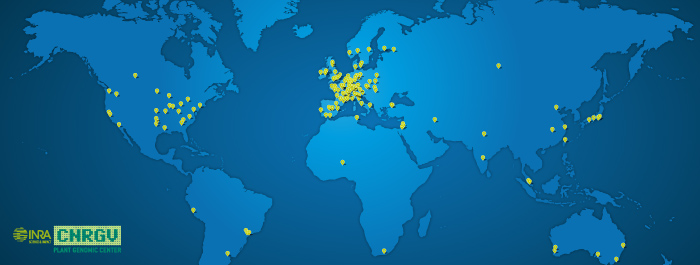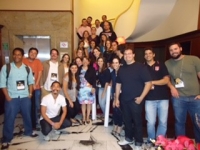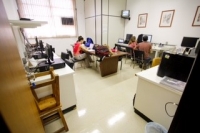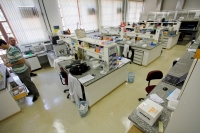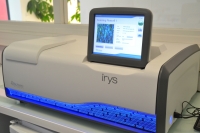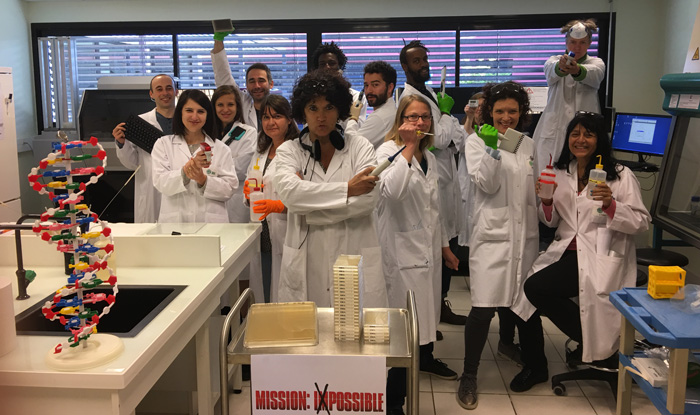Gene@Home - Newsletter May 2017
New Genomic Libraries available :
|
| More than 20 Millions samples are now available at CNRGV: https://cnrgv.toulouse.inra.fr/Library 148 new BAC libraries have been constructed since 2015 by the CNRGV, corresponding to specific genotypes from 28 plant species including wheat, barley, maize, sunflower, pea, and new species like peach tree or sugar beet. |
Success Story :
" The collaboration between LAGM/UNICAMP and CNRGV / INRA started in 2011. It began with the construction of a BAC library from two economically important sugarcane cultivars from Brazil. Both of these cultivars have been used in genomic studies to study genes of interest. Through the exchange of information between both laboratories and the training course of Danilo Augusto Sforça who spent 9 months at the CNRGV, LAGM/UNICAMP became the first self-sufficient facility in Brazil able to provide BAC libraries construction and analysis.
This collaboration between the two laboratories allowed a significant improvement in the level of genomic studies conducted in the LAGM/UNICAMP laboratory. Various projects are now conducted in the laboratory: the construction of BAC libraries for a fungus with cellulose degradation activity in collaboration with LAGM/CBMEG. Moreover, LAGM/UNICAMP will also begin to construct BAC libraries from plants with economically importance in Brazil, such as the rubber tree, and some species of forage and turf. "
Dr Anete Pereira de Souza
|
|
|
|
And you, what do you expect from the CNRGV ?
Please help us serve you better by taking some minutes to answer this survey :
https://cnrgv.toulouse.inra.fr/survey/survey_2017
New collaborations and projects :
- ERC LUPIN ROOTS : Unravelling cluster root development in white lupin
- Pyramiding strategy for durable resistance to root-knot nematodes in Prunus Rootstocks
- Identifying sequences associated with virus tolerance in cassava
- Controling Recombination rate for pOlyploid Crop improvement (CROC)
Genome optical mapping : An Irys Instrument to analyze complex genomes
In order to have a better understanding of complex genomes the CNRGV has acquired the Irys Instrument from BioNano Genomics (http://bionanogenomics.com/). This technology allows the rapid construction of whole genome physical map. This is a precious tool in order to study genomes organization.
Optical Mapping is based on direct visualization of long DNA molecules labeled on specific sequences patterns. DNA is extracted with a specific protocol to preserve its physical integrity and labeled with nicking enzymes that recognize a specific sequence. Molecules, from 100kb to over 2Mb, fluorescently labeled are loaded on a chip and stretched into nanochannels by applying an electric current. Images of labeled DNA molecules are made by an immersion microscope. Images are analyzed in order to obtain a specific barcode for each molecule. By comparing their barcodes, a dedicated software assembles overlapping DNA molecules to produce a physical map. A single chip composed of two flowcells has a throughput of 50 to 100 Gb. A minimum of 100X coverage is needed for de novo assembly of a genome.
Main applications for this technology are finishing of genome sequence assembly and discovery of structural variation in close genotypes. Complementing these previous applications, we aim developing new features, such as double labeling, to visualize regions of interest or study methylation regions.
The CNRGV have started by the Sunflower genome finishing in collaboration with Laboratory of Plant-Microbe Interactions in the frame of the Sunrise project. The cultivated sunflower has a genome of 3.6 Gb. At the beginning of our project, the sunflower genome sequenced with the PacBio RSII technology was assembled into 12 318 contigs with a N50 of 524 Kb and a total size of 2,93 Gb which represent 80% of the genome. Using the BioNano technology, we built two different optical maps built with 2 different nicking enzymes (BspQI and BsssI). The first map was composed by 2000 scaffolds with a N50 of 2 Mb and the second one by 4000 scaffold with a N50 of 1Mb. The combination of optical map and sequence assembly, called Hybrid Scaffolding, allowed to improve the quality of the final assembly by almost 12 times with a N50 of 6 Mb.
This technology therefore offers new possibilities to contribute to the understanding of genomes. It will not only improve the assembly of genomes obtained from new sequencing technologies but also will allow to explore diversity within a species by demonstrating structural variations: insertion, deletion, translocation, copy number variation (CNV).
|
| Funded by : |
|
|
BAC clone characterization : PacBio sequencing
The CNRGV aims to offer a comprehensive service from plant DNA extraction to the characterization of genetic information underpinning a trait of interest. To meet this goal the CNRGV currently utilizes Next Generation Sequencing (NGS) technologies to effectively analyze BAC clones of interest. We focus in particular on the quality of the assembly and on finding various solutions that enable us to achieve this.
Long reads up to 60kb to reach the perfect assembly
| This NGS method available since few years produces 9kb average read length and up to 1Gb of data for 1 SMRT cell, the longest reads can be up to 60kb. Depending on the characteristics of the BAC clones to sequence (complexity of the region, BAC clones overlapping,…), we use different sequencing strategies. BAC clones are pooled with or without tagging, sequenced together on one SMRT cell with the P6C4 chemistry. The sequencing is carried out in collaboration with the Sequencing Platform of Toulouse which has a PacBio RSII sequencer. The DNA of each BAC clone is prepared in CNRGV using the best protocol to obtain high quality samples. The CNRGV is also responsible for the preparation of sequencing libraries. |
|
A new pipeline has been specifically developed by the CNRGV to analyse PacBio data and reach the best quality assembly. Each BAC is then individualized by matching their BES (BAC Ends Sequences) on the ends of assembled contigs.
Last scientific publications :
- Patterns of polymorphism at the self-incompatibility locus in 1,083 Arabidopsis thaliana genomes.
- Repeat-length variation in a wheat cellulose synthase-like gene is associated with altered tiller number and stem cell wall composition
- The chloroplast genome of Passiflora edulis (Passifloraceae) assembled from long sequence reads: structural organization and phylogenomic studies in Malpighiales
- Loss of pollen-specific phospholipase NOT LIKE DAD triggers gynogenesis in maize
- Comparative Analysis of WRKY Genes Potentially Involved in Salt Stress Responses in Triticum turgidum L. ssp. durum.
- The Impact of Open Pollination on the Structural Evolutionary Dynamics, Meiotic Behavior and Fertility of Resynthesized Allotetraploid Brassica napus L.
- Extraction of high-molecular-weight genomic DNA for long-read sequencing of single molecules
- A bacterial artificial chromosome (BAC) genomic approach reveals partial clustering of the furanocoumarin pathway genes in parsnip
- Long Read Sequencing Technology to Solve Complex Genomic Regions Assembly in Plants
- A Metabolic Gene Cluster in the Wheat W1 and the Barley Cer-cqu Loci Determines β-Diketone Biosynthesis and Glaucousness
- Suppressed recombination and unique candidate genes in the divergent haplotype encoding Fhb1, a major Fusarium head blight resistance locus in wheat
- Advancing Eucalyptus Genomics: Cytogenomics Reveals Conservation of Eucalyptus Genomes
- The Cer-cqu gene cluster determines three key players in a β-diketone synthase polyketide pathway synthesizing aliphatics in epicuticular waxes
Highlights :
- Science Festival 2016 : Open lab tour for schoolchildren in CNRGV to discover the DNA molecule
- CNRGV at the International Agricultural Show 2016 : The CNRGV participated to the International Agricultural Show for INRA 70th anniversary from February 27th to March 6th 2016
- Helene Berges received French Legion d'Honneur chevalier rank : By a decree of April 3rd 2015, Helene Berges has been selected to receive French Legion d'Honneur chevalier rank
- 10 Years of Activity Report – 2014 : In 2014, the CNRGV celebrated 10 years of activity, on this occasion an activity report was written.

